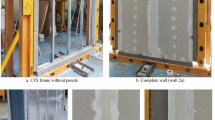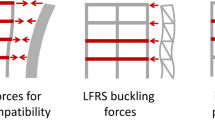Abstract
Non-structural drywall partitions are the most common lightweight partition type used in buildings (especially in US and NZ). They are usually bounded by either a structural frame or by two floor slabs, which makes them damage prone due to imposed inter-storey deformations. The loss of serviceability occurs at very low drift levels, sometimes lower than the design limits set by the current international standards. As part of a research programme for the development of low damage seismic solutions for non-structural vertical elements, experimental and numerical studies have been carried out. This paper will initially report the inherent low seismic performance of drywalls constructed as per typical practice. Then, the developed low damage solutions, capable of reaching high levels of drift without loss of serviceability will be reported. These solutions have been developed based on refinements of existing drywall detailing. An overview of the connection details and of the results of the experimental campaign is herein reported for steel and timber framed drywall practices. The experimental results were integrated with numerical analyses based on a lumped plasticity approach model developed in Ruaumoko2D. A case study building representing a ten storey reinforced concrete building designed according to the NZ Concrete Standard NZS3101 (Part 1: the design of concrete structures. Concrete structures standard, vol 3101. New Zealand Standard 2006) was subjected to a set of ground motions recorded during the 4th September 2010 and the 22nd February 2011 earthquakes in Christchurch. The experimental and numerical campaign confirmed the enhanced performance of the proposed low damage solutions for drywall partitions, based on simple reconfiguration and detailing of the traditional solutions adopted in current practice.

























Similar content being viewed by others
References
ACI374.1-05 (2005) Acceptance criteria for moment frames based on structural testing and commentary, vol 374.1-05. American Concrete Institute
Adham SA, Avanessian V, Hart C, Anderson RW, Elmlinger J, Gregory J (1990) Shear wall resistance of lightgage steel stud wall systems. Earthq Spectra 6(1):1–14
Araya-Letelier G, Miranda E (2012) Novel sliding/frictional connections for improved seismic performance of gypsum wallboard partitions. In: 15th world conference on earthquake engineering, Lisbon, Portugal, 24–28 September 2012
AS/NZS1170.0 (2002) Part 0: general principles. structural design actions, vol 1170. Australian/New Zealand Standard
AS/NZS2589 (2007) Gypsum linings-application and finishing, vol 2589. Australian/New Zealand Standard
ASCE (2010) ASCE/SEI 7–10: minimum design loads for buildings and other structures
Bradley BA (2013) https://sites.google.com/site/brendonabradley/home
Buchanan AH, Palermo A, Carradine D, Pampanin S (2011) Post-tensioned timber frame buildings. Struct Eng IStructE (Inst Struct Eng) 89(17):24–31
Bull DK, Brunsdon D (2008) Examples of concrete structural design to New Zealand Standard 3101 (Red Book). NZCS: Cement & Concrete Association of New Zealand, Wellington, New Zealand
Carr AJ (2013) Ruaumoko 2D-computer program for inelastic time history analysis of structures. University of Canterbury, Christchurch, New Zealand
CEN ECfS (2004) EN 1992-1-1:2004 (Eurocode 2): design of concrete structures-part 1–1: general rules and rules for buildings
Christchurch Earthquake Special Issue (2011) Bulletin of the New Zealand Society for Earthquake Engineering 44 (4)
Darfield Earthquake Special Issue (2010) Bulletin of the New Zealand Society for Earthquake Engineering 43 (4)
Eatherton MR, Hajjar JF (2011) Residual drifts of self-centring systems including effects of ambient building resistance. Earthq Spectra 27(3):719–744
EQC/GNS (2012) GeoNet-geological hazard information for New Zealand
Filiatrault A, Mosqueda G, Retamales R, Davies R, Tian Y, Fuchs J (2010) Experimental seismic fragility of steel studded gypsum partition walls and fire sprinkler piping subsystems. Paper presented at the ASCE structures congress, Orlando, Florida, 12–15 May 2010
Freeman SA (1971) Third progress report on racking tests of wall panels. University of California, Berkeley
GIB (2006) GIB noise control systems-specifications for drywalls
GIB (2010) GIB site guide for residential and commercial installations: CBI 5113. The manufacturer’s installation guidelines
Kanvinde AM, Deierlein GG (2006) Analytical models for the seismic performance of gypsum drywall partitions. Earthq Spectra 22(2):391–411
Lee TH, Kato M, Matsumiya T, Suita K, Nakashima M (2006) Seismic performance evaluation of non-structural components: drywall partitions. Earthq Eng Struct Dyn. doi:10.1002/eqe.638
Macalloy (2007) Macalloy 1030 post tensioning kit, internal bonded or unbonded bar post-tensioning kit using high tensile plain bar 25 to 40 mm and ribbed bar 25 to 50 mm in accordance with European Technical Approval ETA-07/0046. ETA-07/0046. EOTA, Kent/United Kingdom
McMullin KM, Merrick DS (2007) Seismic damage thresholds for gypsum wallboard partition walls. J Archit Eng 13(1):22–29
NZS1170.5 (2004) Part 5: earthquake actions-New Zealand. Structural design actions, vol 1170. New Zealand Standard
NZS3101.1 (2006) Part 1: the design of concrete structures. Concrete structures standard, vol 3101. New Zealand Standard
NZS3404.1 (1997) Steel structures standard, vol 3404. Standards New Zealand, New Zealand Standard
Pampanin S, Palermo A, Marriott D (2010) PRESSS design handbook. NZ Concrete Society Inc.
Priestley MJN, Sritharan S, Conley JR, Pampanin S (1999) Preliminary results and conclusions from the PRESSS five-story precast concrete test building. PCI J 44(6):42–67
Rawlinsons (2009) Rawlinsons New Zealand construction handbook, 24th edn. Rawlinsons Media Limited, Auckland, Wellington, Christchurch, Dunedin
Restrepo JI, Bersofsky AM (2011) Performance characteristics of light gage steel stud partition walls. Thin-Walled Struct 49(2):317–324
Restrepo JI, Lang AF (2011) Study of loading protocols in light-gauge stud partition walls. Earthq Spectra 27(4):1169–1185
Rihal SS (1980) Racking tests of non-structural building partitions. California Polytechnic State University
Taghavi S, Miranda E (2003) Response assessment of nonstructural building elements. Pacific Earthquake Engineering Research Center
Wang ML (1987) Cladding performance on a full scale test frame. Earthq Spectra 3(1):119–172
Acknowledgments
The authors would like to express their gratitude to the Foundation for Research, Science and Technology (FRST) and the Ministry of Science and Innovation (MSI), through the Natural Hazard Research Platform (NHRP), for supporting this research as part of the projects “Non-Structural Elements in Building Seismic Performance” and “Improved Seismic Performance of Non-Structural Elements” respectively. The authors also wish to extend their acknowledgements to Hans Gerlich, Bruce Levey (Winstone Wallboards Ltd.) for providing the material, labor, practical advice during the preparation of the drywalls and to Gavin Keats (Technical Staff-University of Canterbury) for the technical help throughout the whole research project.
Author information
Authors and Affiliations
Corresponding author
Rights and permissions
About this article
Cite this article
Tasligedik, A.S., Pampanin, S. & Palermo, A. Low damage seismic solutions for non-structural drywall partitions. Bull Earthquake Eng 13, 1029–1050 (2015). https://doi.org/10.1007/s10518-014-9654-5
Received:
Accepted:
Published:
Issue Date:
DOI: https://doi.org/10.1007/s10518-014-9654-5




